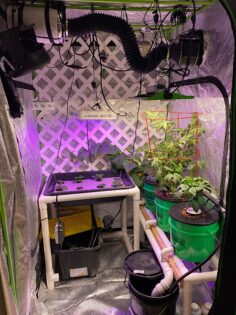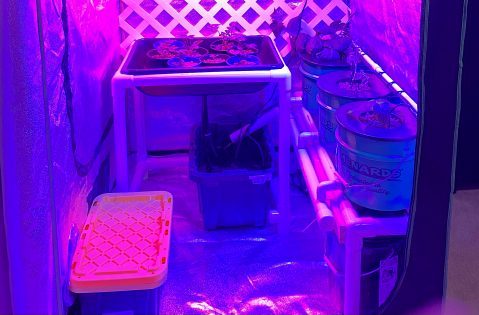When I first started hydroponics I didn’t have my garden enclosed. It soon became evident that I needed to get a grow tent.
Besides the actual tent itself, I wasn’t sure exactly where to start. I thought I’d share my setup to give you a starting point. Here is everything you need to assemble a hydroponic grow tent!

The Hydroponic Grow Tent
First, you’ll need the tent itself. Sizes range from small cubes to walk-in greenhouses.
The tent I use now is 48″ x 48″ x 80″. I don’t have much floor space, but I wanted something tall enough to stand in. With hydroponics, vertical space matters — systems often elevate the plant above the ground, so having height lets you raise your grow lights and grow taller plants.
If you’re curious, here’s my full review of the Vivosun Hydroponic Grow Tent.
Grow Light(s)
LED grow lights are the go-to choice for most home hydroponic growers today — they’re powerful, efficient, and generate less heat than older lights.
When choosing lights:
- Match light coverage to your tent size
- Use multiple lights if growing several plants, so everything gets even exposure
More light = more photosynthesis = more growth (within reason).
How to Choose the BEST LED Grow Light for Your Hydroponic Garden
My Top Pick | 1,600+ Reviews |
Rope Hangers
If your lights don’t come with rope hangers, get some. They’re cheap and essential.
As your plants grow, you’ll need to adjust the height of your lights. Rope hangers make that process simple.
Ventilation System
Don’t skip this. Proper airflow helps with:
- Controlling heat and humidity
- Circulating CO₂ and oxygen
- Reducing mold, mildew, and pests
A basic ventilation setup includes:
- Ventilation fan unit
- Ducting
- Optional: carbon filter (for smell control)
I highly recommend my AC Infinity system, which auto-activates based on temp or humidity and has a built-in LCD controller. Super slick.
Hydroponic System(s)
Depending on your space and goals, you can use more than one hydroponic system in a single tent.
In my current setup:
- I grow strawberries in an ebb and flow system
- And tomatoes, cucumbers, and peppers in a drip system
You can go DIY like I did or buy pre-built systems — either works as long as you use the space wisely.

Power Strip
You’ll be plugging in quite a few things (lights, fans, pumps, timers), so a reliable power strip is a must.
I use a Geeni Wi-Fi-enabled power strip that lets me control outlets and timers through the app. You can:
- Turn devices on/off remotely
- Set lighting and watering schedules
• • Avoid dealing with extra timers
Check out my full review of the Geeni power strip here…
Fans
Plants need to breathe, too. A small fan helps circulate air inside the tent, which:
- Strengthens stems
- Lowers the chance of pests and mold
- Keeps temperature more consistent
I use a basic Honeywell fan, but clamp-on grow tent fans are also great and save floor space.
Timers
If your power strip doesn’t have built-in timers, grab a couple of old-school ones.
Use timers to:
- Control light cycles for plant growth
- Schedule pump operation in ebb & flow or drip systems
I personally prefer the analog kind with push-pins — simple, cheap, and reliable.
Velcro Straps
Not essential, but definitely helpful. Use velcro straps to:
- Tidy up power cords
- Secure lights or ducting
- Keep your grow tent neat and functional
Any cheap straps will do — no need to overthink it.
Final Thoughts
With a little planning and the right components, building a hydroponic grow tent is easier than you might think. Focus on quality where it counts (lights, airflow, and timers) to reduce headaches later on.
I hope this guide helps you get started on the right foot. If you’ve found any game-changing gear for your grow tent, drop it in the comments — I’m always looking for upgrades.









